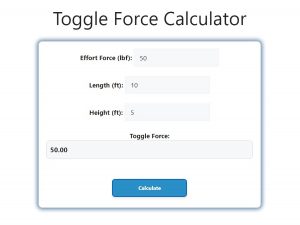About Toggle Force Calculator (Formula)
The Toggle Force Calculator is an essential tool in mechanical engineering and design, helping users calculate the force required to activate a toggle mechanism effectively. Toggle mechanisms are widely used in various applications, including clamping devices and mechanical presses, where efficient force transfer is crucial. By understanding how to utilize this calculator, engineers and technicians can optimize their designs for performance and reliability.
Formula
The formula for calculating toggle force is:
Toggle Force (TF) = (Effort Force * Length) / (2 * Height).
This equation highlights the relationship between the effort force applied, the length of the lever arm, and the height of the toggle mechanism.
How to Use
Using the Toggle Force Calculator is straightforward:
- Input Effort Force: Enter the force being applied to the toggle mechanism.
- Input Length: Specify the length of the lever arm from the pivot point to where the effort force is applied.
- Input Height: Provide the height at which the force is applied in relation to the pivot point.
- Calculate: The calculator will compute the toggle force required for the mechanism based on the provided inputs.
- Interpret the Results: The calculated toggle force helps assess the effectiveness of the design and ensures that the applied force is sufficient for the desired operation.
Example
For example, if a user applies an effort force of 50 pounds, with a lever arm length of 10 inches and a height of 5 inches, the toggle force can be calculated as follows:
TF = (50 * 10) / (2 * 5) = 500 / 10 = 50 pounds.
This means the toggle force required for this configuration is 50 pounds.

FAQs
1. What is toggle force?
Toggle force is the amount of force required to activate a toggle mechanism, allowing for efficient motion and clamping.
2. Why is toggle force important?
Understanding toggle force is crucial for ensuring that mechanisms operate effectively without excessive effort or risk of failure.
3. How does the length of the lever arm affect toggle force?
A longer lever arm can reduce the effort needed to achieve the same toggle force, making the mechanism easier to operate.
4. What happens if the toggle force is too low?
If the toggle force is insufficient, the mechanism may not engage properly, leading to inefficiencies or failure in operation.
5. Can I use this calculator for different types of toggle mechanisms?
Yes, the calculator can be applied to various toggle mechanisms, provided you have the relevant measurements for effort force, length, and height.
6. How do I measure effort force?
Effort force can be measured using a force gauge or calculated based on the weight being applied to the toggle mechanism.
7. What units can I use with the Toggle Force Calculator?
The calculator typically accepts force in pounds or newtons, and length and height in inches or centimeters.
8. Can I calculate toggle force for horizontal and vertical applications?
Yes, the calculator can be adapted for both horizontal and vertical toggle mechanisms, as long as the input parameters are accurately provided.
9. What factors should I consider when designing a toggle mechanism?
Considerations include the required toggle force, lever arm length, pivot point placement, and the materials used in construction.
10. How does the height at which force is applied impact toggle force?
The height affects the mechanical advantage of the lever system; a greater height can reduce the toggle force required.
11. Can toggle force calculations help in safety assessments?
Yes, knowing the toggle force can aid in ensuring that mechanisms operate within safe limits and prevent overload conditions.
12. What materials are commonly used in toggle mechanisms?
Common materials include steel, aluminum, and various plastics, depending on the required strength and application.
13. Is the Toggle Force Calculator applicable in robotics?
Yes, it is useful in robotics for designing actuators and mechanisms that require precise force calculations.
14. How do friction and other losses affect toggle force?
Friction and mechanical losses can increase the required effort force, thus affecting the calculated toggle force.
15. Can I use the Toggle Force Calculator for manual tools?
Yes, the calculator can be applied to manual tools, such as clamps and levers, to determine their operational force requirements.
16. What is the relationship between toggle force and mechanical advantage?
The toggle force is influenced by the mechanical advantage provided by the lever system, allowing for reduced effort to achieve the desired force.
17. How often should toggle force calculations be performed?
Toggle force calculations should be performed whenever there are changes in design or materials, or when assessing performance in existing mechanisms.
18. What are common applications of toggle mechanisms?
Common applications include clamping devices, mechanical presses, and various types of jigs and fixtures in manufacturing.
19. Can the Toggle Force Calculator assist in prototyping?
Yes, it can help engineers and designers determine the feasibility of their prototypes and make adjustments as needed.
20. How can I ensure accurate results when using the calculator?
To ensure accuracy, use precise measurements for effort force, lever length, and height, and double-check unit conversions.
Conclusion
The Toggle Force Calculator is a powerful tool for engineers and designers, providing valuable insights into the forces required for effective toggle mechanism operation. By understanding and applying the principles behind toggle force calculations, users can optimize their designs, ensuring reliable and efficient performance in various applications. Whether for industrial machinery or DIY projects, mastering toggle force can significantly enhance mechanical systems’ effectiveness.